The egg cell, also known as the ovum, is the female reproductive cell. The egg cell is released from the ovaries in the female reproductive system.
The egg cell is the female gamete responsible for reproduction in female organisms. This cell is formed through the process of oogenesis. It has the potential to develop into a new organism when it joins with a sperm cell. Over time, the egg cell matures. Some remain inactive for many years before maturing, while others never fully develop.
The egg cell contains a central nucleus with the female’s genetic material. This, combined with the genetic material from the sperm cell during fertilization, determines the characteristics of the future child. These egg cells are characterized by their haploid nature, containing half the number of chromosomes found in the parent cell.
Interesting Science Videos
Anatomy and Structure of Egg Cell
An egg cell is generally spherical and non-motile, varying in size across different animals. Size ranges from 10 millimeters to a few centimeters in length.
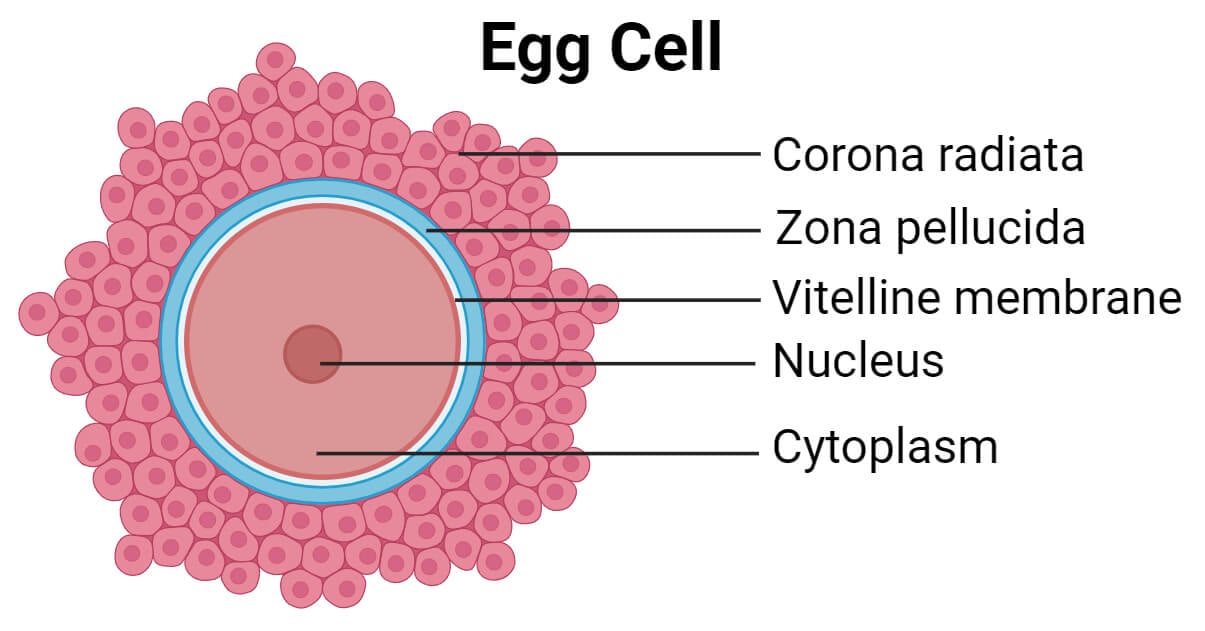
The egg cell is surrounded by three layers externally:
- Corona radiata is the outermost layer surrounding the egg cell and consists of follicular cells. These cells play a role in nourishing and protecting the egg.
- Zona pellucida is the thick, transparent, and non-cellular layer located beneath the corona radiata. It is composed of glycoproteins and provides structural support to the egg. It also plays a crucial role in sperm-egg interaction during fertilization.
- Vitelline membrane is the innermost layer, which is a thin, transparent membrane secreted by the egg cell itself. This membrane provides additional protection to the egg.
The cytoplasm of the egg cell is divided into outer exoplasm or egg cortex and inner endoplasm or ooplasm.
The cortex contains cytoskeletal structures like microtubules and microfilaments. It also holds pigment granules and cortical granules. The ooplasm contains cell organelles, tRNAs, histones, enzymes, etc.
Cortical granules are found in the outer cortex of the egg cytoplasm and play an important role in the activation of the egg upon sperm entry. Cortical granules modify the egg coat to prevent multiple sperm from fertilizing the egg.
The egg cytoplasm also contains essential reserves in the form of yolk which provides essential proteins, lipids, and other nutrients necessary for early development. The yolk is located in the ooplasm.
The nucleus of the ovum, called the germinal vesicle, is large and contains genetic material in the form of DNA, which is essential for the development of the embryo. The side of the egg cell with the nucleus and polar body is the animal pole, while the opposite side is the vegetal pole.
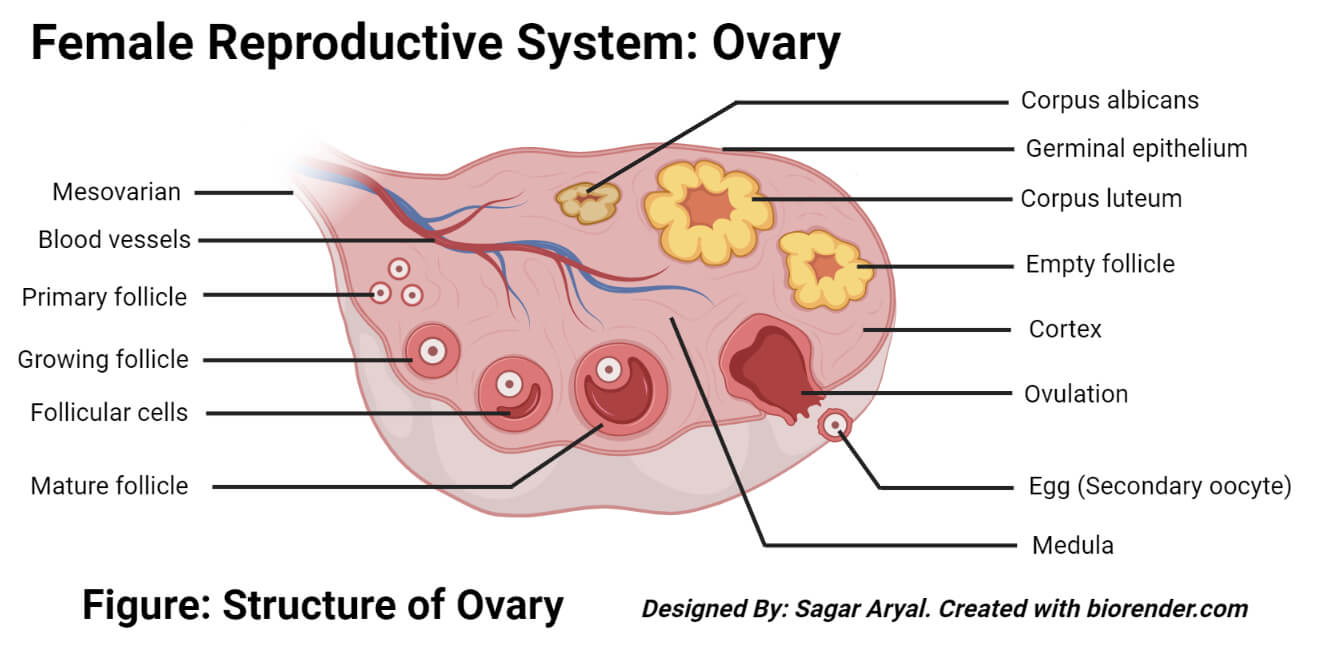
Oogenesis
Egg cell development, known as oogenesis, progresses through several stages where the primary egg cell matures into a fully developed egg. While the process of oogenesis differs among species, the general stages follow a similar pattern.
- Formation of Oogonia: Oogenesis starts with the formation of oogonia which are the precursor cells of eggs. These cells are formed from the primordial germ cells which migrate into developing gonads during the early stages of embryonic development.
- Primary Oocyte Development: Oogonia mature into primary oocytes. In mammals, this stage often begins before the female is even born. By the time of birth, all the egg cells that will be released from the ovaries during the reproductive years are already present as primary oocytes. The primary oocytes are then ready to begin the meiosis I division. During meiotic division I, the DNA replicates, forming two sister chromatids for each chromosome. Homologous chromosomes align and exchange genetic material.
- Prophase I Arrest: The primary oocytes then enter prophase I of meiosis, where they remain arrested for a long period. During this phase, the primary oocytes synthesize important components such as a protective coat, cortical granules, and various nutrients essential for embryonic growth.
- Oocyte Maturation: Upon reaching sexual maturity, oocyte maturation starts. Under the influence of hormones, the cell completes meiosis I. Here, the chromosomes recondense, the nuclear envelope disintegrates, and homologous chromosomes segregate. This forms a small polar body and a large secondary oocyte.
- Meiotic Division II: In division II of meiosis, the secondary oocyte further divides, producing a mature egg and another polar body.
- Release and Fertilization: The mature egg remains arrested at metaphase II until ovulation. Upon release from the ovary, it travels through the fallopian tubes, where it waits for potential fertilization by male sperm cells.
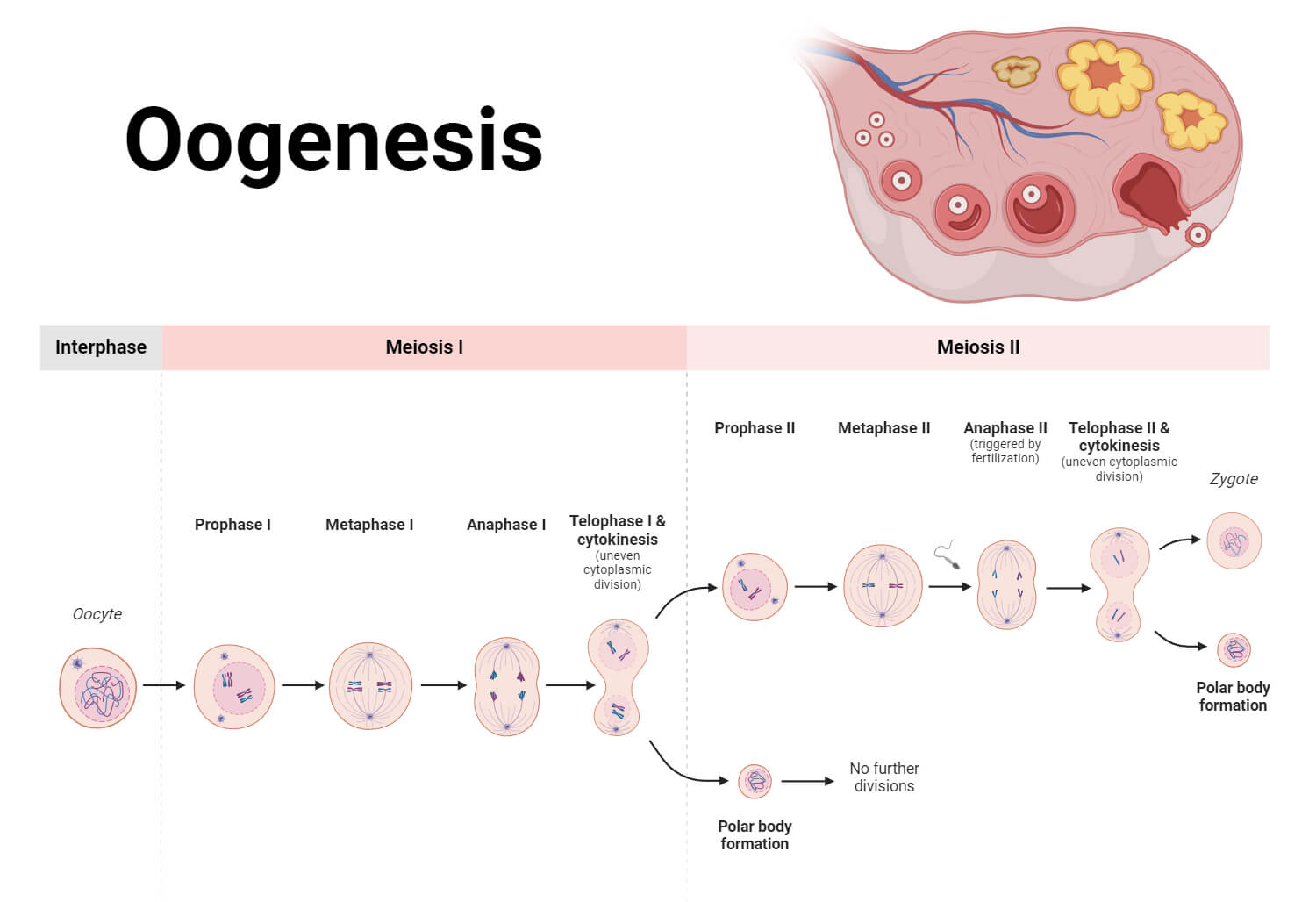
Types of Female Egg Cell
Various types of egg cells are classified on the basis of the amount and distribution of yolk.
Based on yolk amount
- Alecithal eggs lack yolk or have very little yolk distributed throughout the cytoplasm. They are common in organisms like mammals, where the developing embryo is sustained by the mother’s placenta.
- Microlecithal eggs contain a small to moderate amount of yolk. This type of egg is common in sea urchins and some marine invertebrates.
- Mesolecithal eggs have a moderate amount of yolk, which is typically concentrated near the vegetal pole of the egg. This category includes eggs from amphibians such as frogs, toads, and some fish.
- Polylecithal or Macrolecithal eggs have a large amount of yolk. This type of egg is found in organisms like sharks, bony fishes, reptiles, birds, and insects.
Based on yolk distribution
- Isolecithal eggs have a moderate amount of yolk, which is uniformly distributed throughout the egg. Such distribution is observed in alecithal and microlecithal eggs.
- Telolecithal eggs have most of their yolk near the vegetal pole, with the cytoplasm and nucleus situated near the animal pole. This distribution is observed in mesolecithal and macrolecithal eggs.
- Centrolecithal eggs have a centrally located yolk. Certain insects have centrolecithal eggs.
Functions of Egg Cell
The female egg cells have several functions:
- The primary function of egg cells is to combine with sperm cells during fertilization, forming a zygote, that matures into a new organism. Egg cells carry half of the genetic material required to form a new individual.
- Egg cells are rich in cytoplasmic components, such as yolk, which provide essential nutrients for the developing embryo.
- Egg cells release chemical signals and molecules that attract sperm cells and facilitate their entry into the egg during fertilization.
- Upon fertilization, the egg changes its membrane potential and biochemical processes, activating the zygote for cell division and embryonic development.
- Egg cells help to prevent fertilization by multiple sperm cells, ensuring that only one sperm can successfully fertilize the egg.
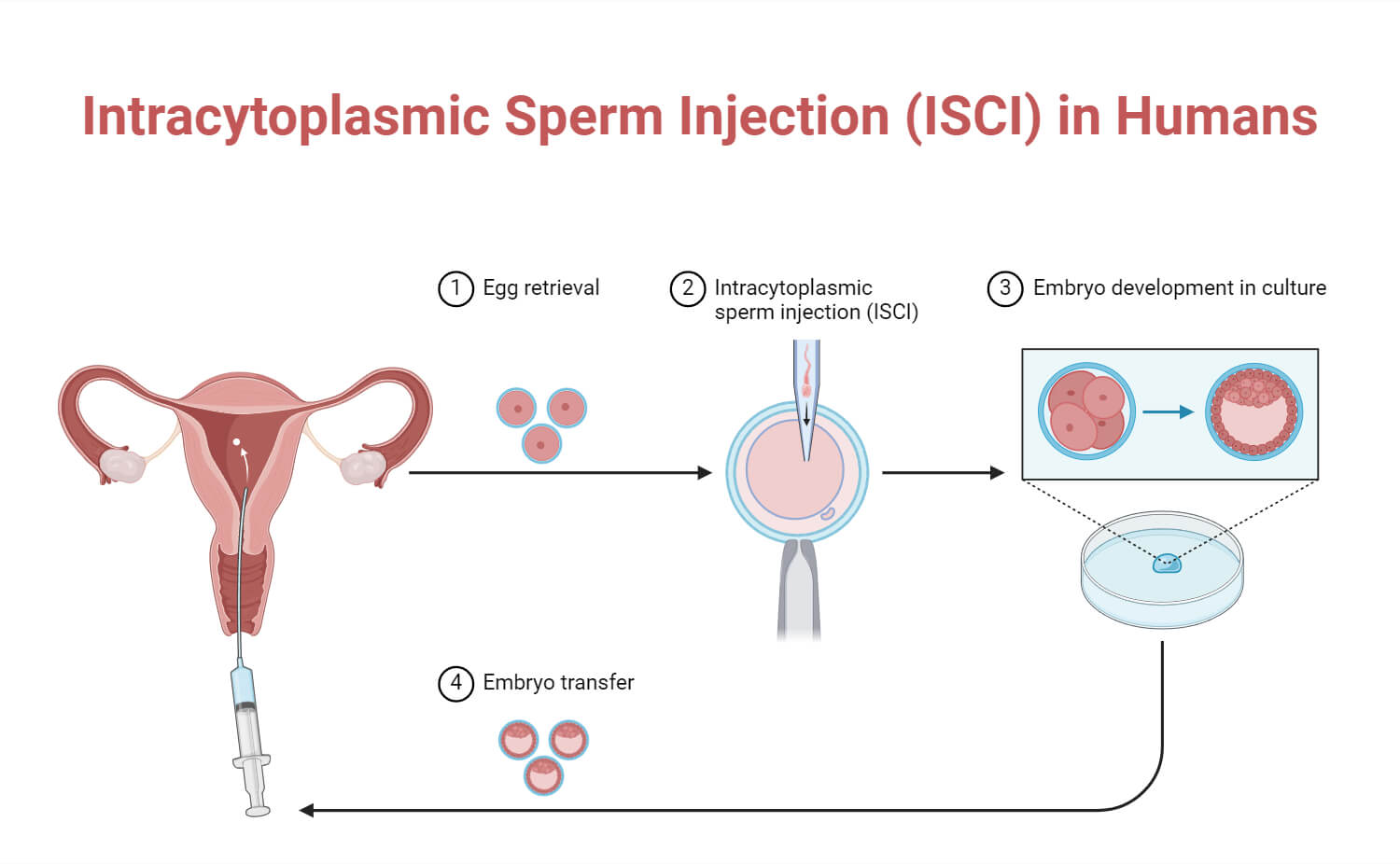
Diseases and Disorders of Egg Cell
Several diseases and disorders are associated with the female egg cells. Some of the common disorders include:
- Polycystic Ovary Syndrome (PCOS) is a common hormonal disorder in women of reproductive age. It causes irregular menstrual cycles, elevated androgen levels, excess body hair, and abnormal growths on the ovaries, which were previously thought to be cysts but are now understood as follicles that do not mature properly. PCOS often leads to fertility issues due to irregular ovulation. The exact cause is unknown, but the risk of developing it is increased with a family history and type 2 diabetes. There is no cure for PCOS but symptoms can be managed with lifestyle changes and medications.
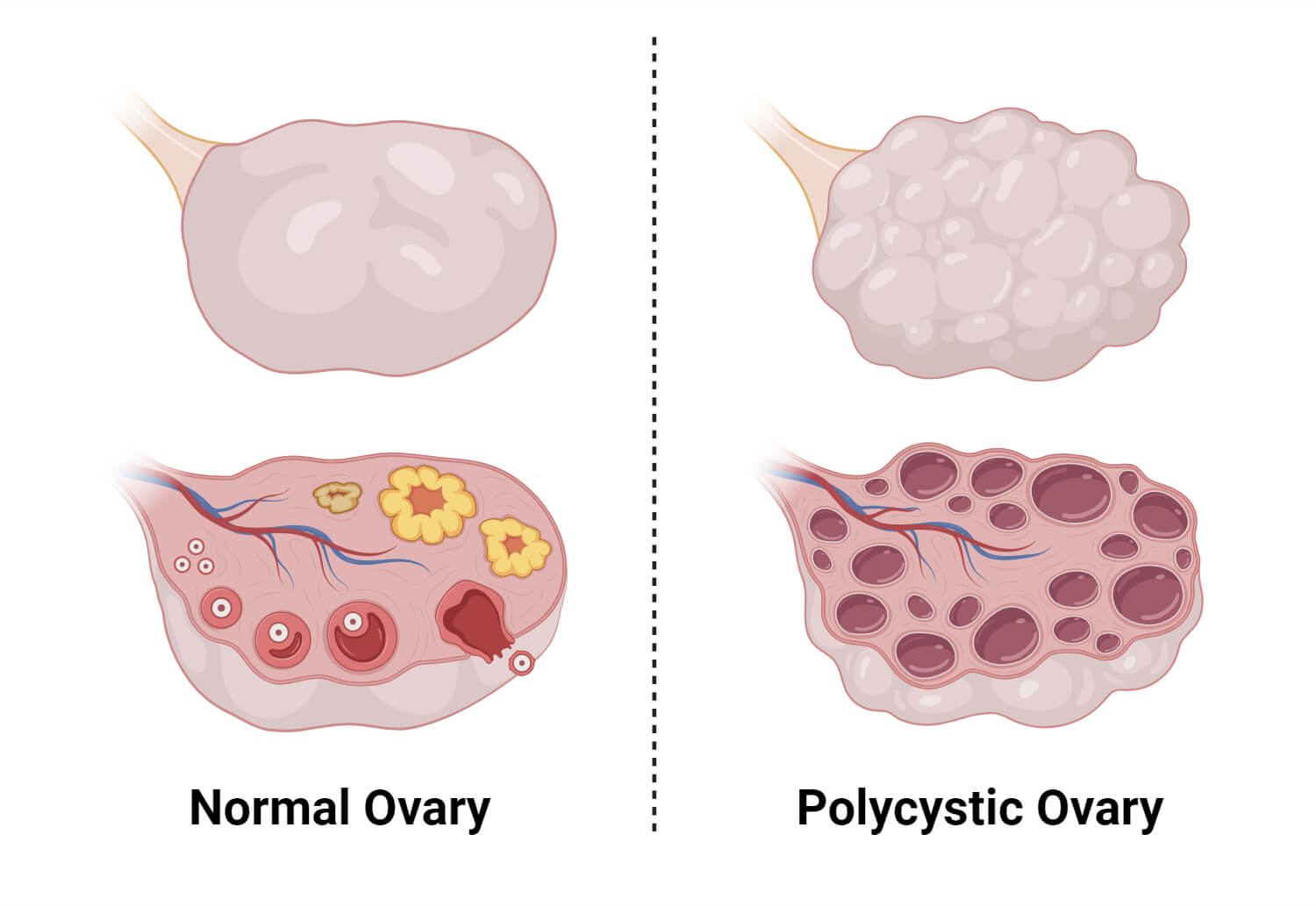
- Endometriosis is characterized by the growth of tissue similar to the uterine lining outside the uterus, often causing pain and fertility issues. It can form cysts on the ovaries, hindering egg release. Common sites include the ovaries, pelvic ligaments, and even organs like the intestines and bladder. It is a chronic condition without a cure but various treatments can provide relief. Treatment options include pain medications, hormonal therapies, and surgery to remove endometrial tissue.
- Ovarian cysts are sacs filled with fluid that can develop in the ovaries which are usually harmless. Generally, these cysts are functional and benign, disappearing on their own without the need for surgery. However, in some cases, these cysts can grow large, potentially leading to complications such as pelvic pain, cyst rupture, excessive bleeding, and ovarian torsion. This situation requires immediate medical attention and surgical treatment to prevent complications. It is important to remove large cysts to avoid these risks.
- Diminished Ovarian Reserve (DOR) refers to a decreased number or quality of eggs in the ovaries. It can result in difficulty conceiving due to a lower number of eggs available for ovulation. People with DOR may have no symptoms other than difficulty conceiving. Some may notice shorter menstrual cycles. Causes include aging, genetics, medical treatments like chemotherapy, or autoimmune conditions. Treatment options include freezing eggs for later use, attempting natural conception, or IVF with own or donor eggs. Lifestyle factors like weight and avoiding smoking may help egg health.
- Ovarian cancer is a type of cancer where cells in the ovaries grow abnormally. These organs produce eggs during reproductive years. Symptoms of ovarian cancer include pelvic pain, changes in appetite, abnormal bleeding, and bowel changes. Ovarian cancer can spread to other organs if untreated. Staging helps determine treatment options, which include surgery, chemotherapy, targeted therapy, hormone therapy, and rarely, radiation therapy. Ovarian cancer can impact the function of the ovaries, including the production and release of eggs. It can affect the overall health of the ovary, disrupt hormone production, and interfere with the normal processes of ovulation and egg maturation.
- Primary Ovarian Insufficiency (POI) is a condition where the ovaries stop functioning earlier than usual. It is also known as premature ovarian failure. The ovaries produce and release eggs during ovulation, as well as important hormones for menstruation and pregnancy. POI leads to low estrogen and a decrease in the number and quality of eggs, often resulting in infertility. POI is relatively rare, affecting about 1% of women between 15 to 44, more commonly in those over 30. Causes of POI include autoimmune disorders, cancer treatments, genetic disorders like Turner syndrome, and exposure to toxins. Symptoms can vary but often include irregular or absent periods, trouble conceiving, decreased libido, and other menopausal-like symptoms. Treatment focuses on symptom relief and reducing the risks associated with POI. Treatments like IVF and hormone therapy can help manage symptoms and risks, improving quality of life.
References
- Alberts B, Johnson A, Lewis J, et al. Molecular Biology of the Cell. 4th edition. New York: Garland Science; 2002. Eggs. Available from: https://www.ncbi.nlm.nih.gov/books/NBK26842/
- Britannica, T. Editors of Encyclopaedia (2023, December 9). ovum. Encyclopedia Britannica. https://www.britannica.com/science/ovum
- Britannica, T. Editors of Encyclopaedia (2023, November 3). egg. Encyclopedia Britannica. https://www.britannica.com/science/egg-biology
- Britannica, T. Editors of Encyclopaedia (2023, October 22). oogenesis. Encyclopedia Britannica. https://www.britannica.com/science/oogenesis
- Diminished Ovarian Reserve: Causes, Symptoms & Treatment (clevelandclinic.org)
- Endometriosis: Causes, Symptoms, Diagnosis & Treatment (clevelandclinic.org)
- Gilbert SF. Developmental Biology. 6th edition. Sunderland (MA): Sinauer Associates; 2000. Oogenesis. Available from: https://www.ncbi.nlm.nih.gov/books/NBK10008/
- Mobeen S, Apostol R. Ovarian Cyst. [Updated 2023 Jun 5]. In: StatPearls [Internet]. Treasure Island (FL): StatPearls Publishing; 2024 Jan-. Available from: https://www.ncbi.nlm.nih.gov/books/NBK560541/
- PCOS (Polycystic Ovary Syndrome): Symptoms & Treatment (clevelandclinic.org)
- Primary Ovarian Insufficiency: Causes, Symptoms & Treatment (clevelandclinic.org)
- Rasquin LI, Anastasopoulou C, Mayrin JV. Polycystic Ovarian Disease. [Updated 2022 Nov 15]. In: StatPearls [Internet]. Treasure Island (FL): StatPearls Publishing; 2024 Jan-. Available from: https://www.ncbi.nlm.nih.gov/books/NBK459251/
